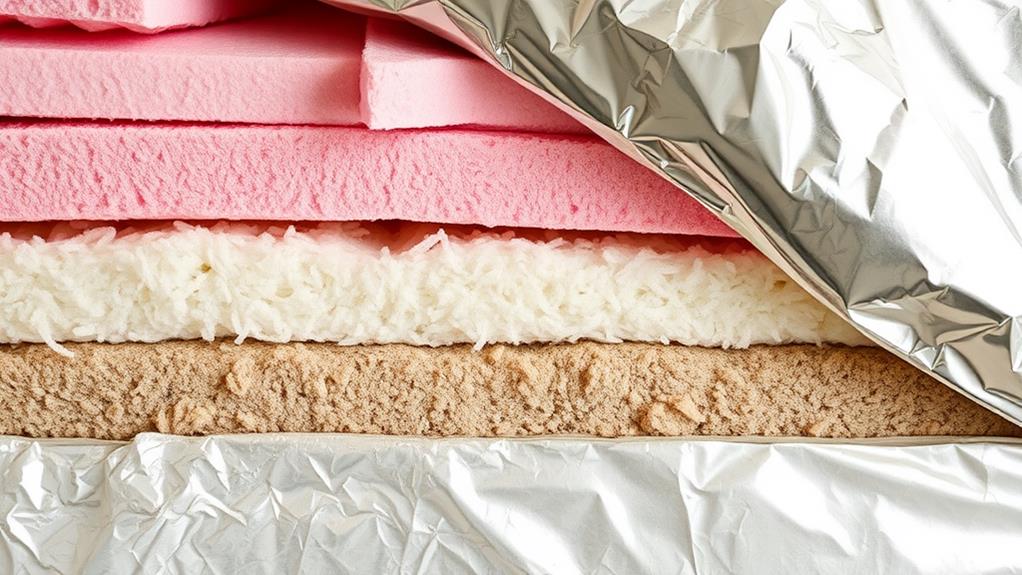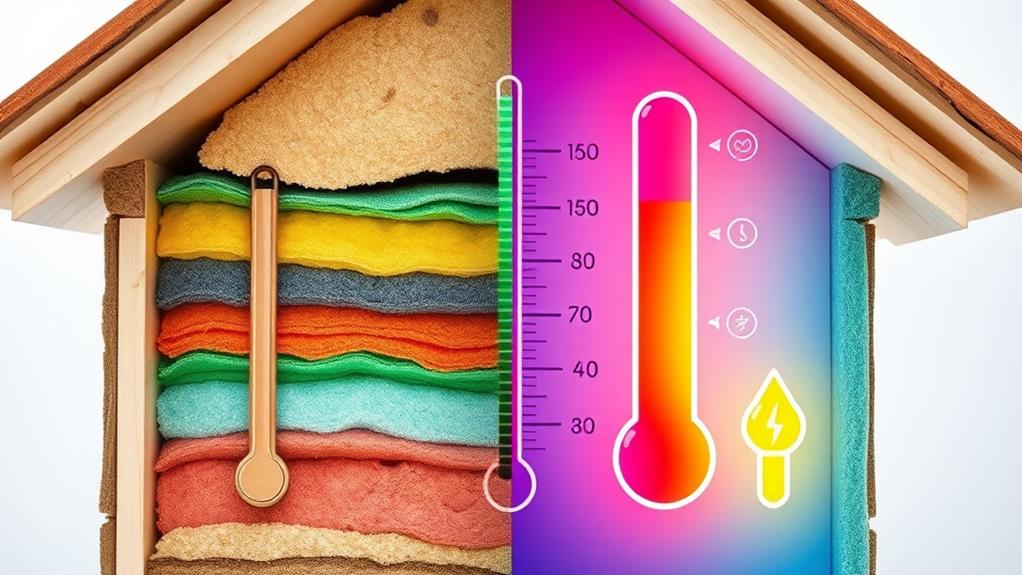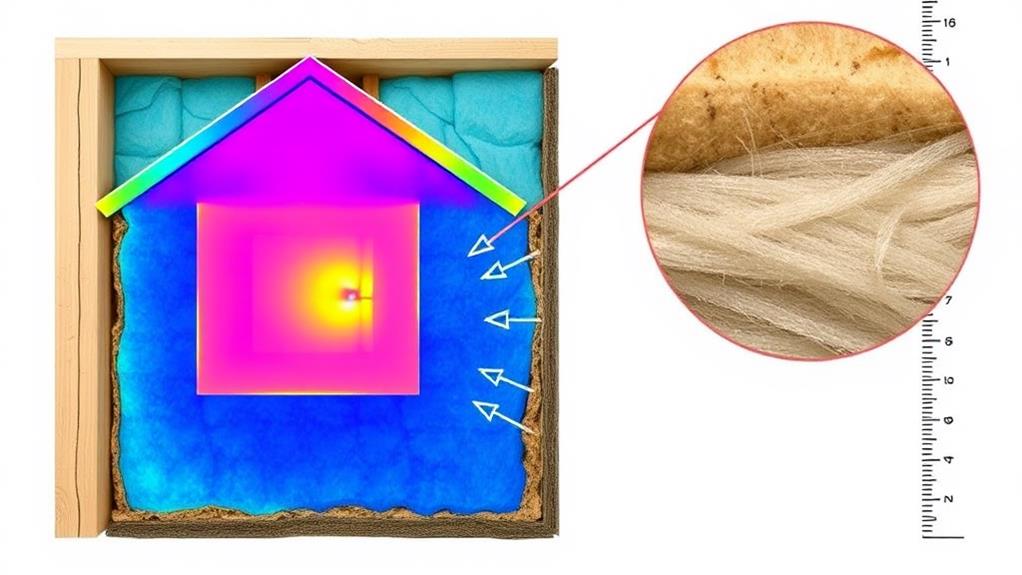R-values measure how well insulation resists heat flow, with higher numbers indicating better performance. For your home, understanding R-values helps you choose the right insulation for your climate and needs. Different areas of your house require specific R-values: attics in cold climates need R-49 to R-60, while walls might only need R-13 to R-21. Various insulation materials, like fiberglass, cellulose, and spray foam, offer different R-values per inch. Proper installation and moisture control are crucial for maintaining insulation effectiveness. By calculating your home's current R-value and comparing it to recommendations, you'll know if it's time to upgrade. Exploring insulation options can lead to significant energy savings and improved comfort.
The Basics of R-Values

Insulation is the unsung hero of energy efficiency in your home. It's the barrier that keeps heat where you want it, whether that's inside during winter or outside during summer. At the heart of understanding insulation's effectiveness is the R-value.
R-value measures thermal resistance – how well a material prevents heat transfer. The higher the R-value, the better the insulation performs. It's calculated per inch of material thickness, so a 3-inch layer of insulation with an R-value of 3 per inch would have a total R-value of 9.
Different materials have varying R-values. Fiberglass batts typically range from R-2.2 to R-2.7 per inch, while spray foam can reach R-6 to R-7 per inch. Climate plays a crucial role in determining the ideal R-value for your home. Colder regions require higher R-values to maintain comfort and efficiency.
It's important to note that R-values aren't cumulative in a simple additive way. Doubling the thickness of insulation doesn't always double its effectiveness. Factors like air gaps, compression, and moisture can all impact the actual performance of insulation in your home.
Recommended R-Values for Different Climates
When you're planning to insulate your home, it's crucial to consider your local climate. Different regions require varying levels of insulation to maintain comfort and energy efficiency. In colder climates, you'll need higher R-values to keep heat inside, while warmer areas may require less insulation.
For attics in cold climates, like the Northeast or Midwest, aim for R-values between R-49 and R-60. In moderate climates, such as the Mid-Atlantic states, R-38 to R-49 is typically sufficient. For warmer regions like the South, R-30 to R-38 should do the job.
When insulating walls, cold climates benefit from R-13 to R-21, depending on the wall thickness. Moderate climates can use R-13 to R-15, while warm climates may only need R-13.
For floors, cold climates should target R-25 to R-30, moderate climates R-19 to R-25, and warm climates R-13. Remember that these are general guidelines, and your specific needs may vary based on factors like your home's construction, local building codes, and energy costs. It's always best to consult with a professional insulation contractor to determine the ideal R-values for your particular situation.
Types of Insulation Materials

There are six main types of insulation materials commonly used in residential construction. These include fiberglass, cellulose, spray foam, mineral wool, rigid foam, and natural fibers.
Fiberglass is the most common, available in batts or blown-in form. It's cost-effective but can be irritating to install. Cellulose, made from recycled paper products, is eco-friendly and fire-resistant. It's typically blown into walls or attics.
Spray foam comes in two varieties: open-cell and closed-cell. It expands to fill gaps, providing excellent air sealing.
Mineral wool, also called rock wool, is fire-resistant and water-repellent. It's often used in high-temperature areas. Rigid foam boards offer high R-values per inch and are great for exterior sheathing. Natural fibers like cotton, wool, or hemp are eco-friendly alternatives but can be more expensive.
When choosing insulation, consider factors like your climate, budget, and installation method. Each material has its pros and cons, so you'll need to weigh these against your specific needs. Remember, proper installation is crucial for any insulation to perform effectively, regardless of the material you choose.
Factors Affecting Insulation Performance
Effectiveness of insulation isn't solely determined by the material you choose. Several factors can impact how well your insulation performs, and understanding these can help you maximize your home's energy efficiency.
First, proper installation is crucial. Even the highest-rated insulation won't work effectively if there are gaps or compression. Ensure your insulation is installed correctly, filling all cavities without being squished.
Moisture is another significant factor. When insulation gets wet, its R-value decreases dramatically. Proper ventilation and vapor barriers can help prevent moisture buildup and maintain insulation performance.
The age of your insulation also matters. Over time, some materials can settle or degrade, reducing their effectiveness. Regular inspections can help you identify when it's time to replace or add insulation.
Air movement can also impact insulation performance. Drafts and air leaks can bypass your insulation, reducing its effectiveness. Sealing gaps and cracks in your home's envelope can enhance your insulation's performance.
Lastly, consider the climate you live in. Different insulation types perform better in certain conditions, so choose a material that's well-suited to your region's temperature and humidity levels.
Calculating Your Home's R-Value

To accurately determine your home's overall insulation effectiveness, you'll need to calculate its total R-value. Start by identifying all the insulated areas in your home, including walls, attic, floors, and windows. Measure the thickness of each insulation layer and note the material used. Then, look up the R-value per inch for each material in a standard insulation chart.
Multiply the thickness of each layer by its R-value per inch to get the R-value for that specific area. For walls with multiple layers, add the R-values of each layer together. Don't forget to account for air spaces, which have their own R-values.
Next, calculate the total surface area of each insulated section in square feet. Multiply each area's R-value by its surface area, then add all these values together. Finally, divide this sum by the total surface area of your home's insulated sections.
The resulting number is your home's overall R-value. Compare this to recommended R-values for your climate zone to determine if your insulation is adequate or if you need improvements. Remember, higher R-values indicate better insulation performance.
Improving Existing Insulation
Once you've determined your home's current R-value, you might find it falls short of recommended levels. Don't worry; there are several ways to improve your existing insulation. Start by addressing air leaks, which can significantly reduce insulation effectiveness. Seal gaps around windows, doors, and other openings with weatherstripping or caulk.
Next, consider adding insulation to your attic, as it's often the easiest and most cost-effective area to upgrade. You can lay fiberglass batts or blown-in cellulose over existing insulation to boost your R-value.
For walls, you might inject foam insulation into existing cavities or add rigid foam boards during renovations.
Don't forget about your basement or crawl space. Insulating these areas can prevent heat loss and moisture problems. Use foam boards on walls and fiberglass batts between floor joists.
If you're replacing your roof, take the opportunity to add more insulation or switch to higher R-value materials. Similarly, when updating siding, consider adding a layer of rigid foam insulation beneath it.
Cost vs. Energy Savings

When considering insulation upgrades, it's crucial to weigh the initial costs against potential energy savings. The price of insulation varies depending on the type, R-value, and installation method. While higher R-value insulation typically costs more upfront, it often leads to greater long-term savings on energy bills.
To determine if an insulation upgrade is cost-effective, calculate the payback period. This is the time it takes for energy savings to offset the initial investment. Factors influencing this calculation include your local climate, current energy prices, and the efficiency of your heating and cooling systems.
Keep in mind that insulation upgrades can also increase your home's value and comfort. You'll likely experience more consistent indoor temperatures and reduced noise levels. Additionally, many regions offer rebates or tax incentives for energy-efficient home improvements, which can help offset initial costs.
When evaluating insulation options, consider the lifespan of different materials. Some types, like fiberglass and cellulose, may settle or degrade over time, reducing their effectiveness. Others, such as spray foam, maintain their R-value longer but come with a higher upfront cost.
Conclusion
You've now got the lowdown on R-values and insulation. Armed with this knowledge, you're ready to tackle your home's energy efficiency like a knight storming a castle. Remember, higher R-values mean better insulation, but climate and cost play crucial roles too. Don't forget to consider different materials and factors affecting performance. By improving your insulation, you'll create a more comfortable home and potentially save big on energy bills. It's time to insulate and dominate!

